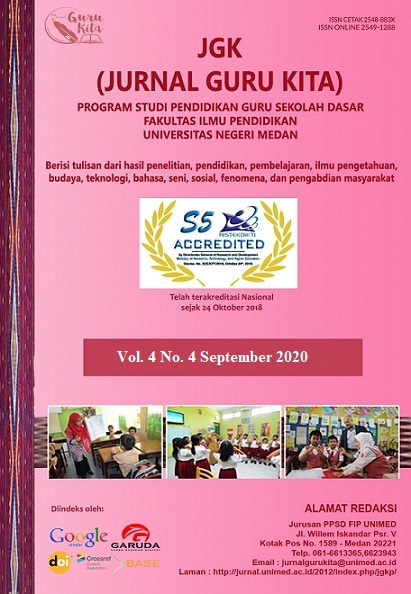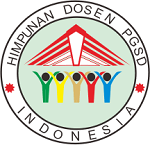PERBANDINGAN MODEL PEMBELAJARAN MURDER DAN AIR TERHADAP HASIL BELAJAR MATEMATIKA SISWA SD NEGERI 153073 ANGGOLI I
DOI:
https://doi.org/10.24114/jgk.v7i1.37866Keywords:
MURDER Model, AIR Model, Mathematics Learning Outcomes.Abstract
The Comparison of Learning Models MURDER and AIR on Mathematics Learning Outcomes of Students at SD Negeri 153073 Anggoli I. The purpose of this study was to determine the differences in mathematics learning outcomes for students at SD Negeri 153073 Anggoli I using the MURDER model with the AIR model. The population in this study were students of SD Negeri 153073 Anggoli I, with a sample of 13 students in grade II-A SD and 13 students in class II-B. The data collection technique was carried out by giving a written technical test and in the form of a description of 10 questions in the form of a pretest and posttest with multiplication and division material. The stages of the research method are normality test, homogeneity test, hypothesis testing. Then analyze the data used in this study using the two sample t-test formula. The mathematics learning outcomes of class II students at SD Negeri 153073 Anggoli I before the application of the MURDER learning model were in the medium category with an average number of 66.92 while after the application of the learning outcomes of students increased with an average number of 83.46. The mathematics learning outcomes of second grade students at SD Negeri 153073 Anggoli I before the implementation of the AIR learning model were in the medium category with an average number of 68.46 while after the application of the students' learning outcomes increased with an average number of 86.92. In testing the hypothesis using the t-test, namely the independent sample t-test, where the data being tested is the data from the posttest results of the two groups. Based on the calculation results of SPSS 16.0, Sign (2 tailed) = 0.003 which means < (0.05 or 5%), then H1 is accepted which means that there is a significant difference between the mathematics learning outcomes of second grade students at SD Negeri 153073 Anggoli I taught through MURDER and AIR learning models.References
Andriyadi & Sukidjo. (2020). The Application of MURDER Learning Model and Effect on Student Learning Outcomes. European Journal of Education Studies. 7(11) : 117-126.
Astuti, W. (2021). Peningkatan Hasil Belajar Melalui Model Auditory Intelectualy Repetition (AIR) dan Model Think Talk Write (TTW). Jurnal Binomial. 4(1) : 53-65.
Ayunani, M. 2012. Penerapan Model Pembelajaran Kooperatif Tipe MURDER (Mood, Understand, Recall, Degest, Expand, Review) Untuk Meningkatkan Hasil Belajar Fisika Siswa Kelas VIII SMP Negeri 16 Palu. Jurnal Pendidikan Fisika Tadulako (JPFT), 1(1): 33-27.
Fathurrahman, M. (2015). Model-Model Pembelajaran Inovatif. Jogjakarta: Arruz Media.
Hasanah R., Ningrum & Pritandhari. (2021). Pengaruh Penggunaan Model Pembelajaran Air (Auditory, Intellectualy, Repetition) Berbantu Question Card Terhadap Hasil Belajar Ips Terpadu.
Hidayati, Nur Alfin and Darmuki, Agus (2021) Penerapan Model Auditory Intellectually Repetition (AIR) Untuk Meningkatkan Kemampuan Berbicara pada Mahasiswa (Turnitin). Jurnal Educatio, 7 (1). pp. 252-259.
Jozestani, L. K., A. Yarmohamadian, & M. Malekpur. (2015). Effectiveness of MURDER Method on the Improvement of Academic Performance of Children with Spelling Learning Disorder. Megazineof E-Learning Distibution in Academic, 6(3): 61-69.
Puspitasari, D. (2017). Efek Model Pembelajaran Kooperatif Tipe Murder Berbasis Mind Mapping Terhadap Prestasi Dan Kreativitas. Wahana Islamika: Jurnal Studi Keislaman. 3(2): 113-139.
Sanjaya, F., Astuti, B & Handayani,. L. (2019). Keefektifan Model Pembelajaran Murder (Mood, Understand, Recall, Detect, Elaborate, Review) Melalui Teknik Kie Untuk Meningkatkan Aspek Sebab Akibat Kemampuan Generik Sains Siswa. Indonesian Journal of Natural Science Education (IJNSE). 2(1) : 134-140.
Silviana, D. dan Mardiani. D. (2021). Perbandingan Kemampuan Pemahaman Matematis Siswa melalui Mood-Understand-Recall-Digest-Expand-Review dan Discovery Learning. Plus Minus: Jurnal Pendidikan Matematika. 1(2): 291-302
Thomas, P., Czerwinski, M., McDuff, D., Craswell, N., & Mark, G. (2018). Style and alignment in information-seeking conversation. In Proceedings of the 2018. Conference on Human Information Interaction & Retrieval (pp. 42-51).
Downloads
Published
How to Cite
Issue
Section
License
Authors published with the JGK (Jurnal Guru Kita) agree to the following terms:
- Authors retain copyright and grant the journal the right of first publication with the work simultaneously licensed under a Creative Commons Attribution License (CC BY-SA 4.0) that allows others to share the work with an acknowledgment of the work's authorship and initial publication in this journal.
- Authors are able to enter into separate, additional contractual arrangements for the non-exclusive distribution of the journal's published version of the work (e.g., post it to an institutional repository or publish it in a book), with an acknowledgment of its initial publication in this journal.
- Authors are permitted and encouraged to post their work online (e.g., in institutional repositories or on their website) prior to and during the submission process, as it can lead to productive exchanges, as well as earlier and greater citation of published work. (See The Effect of Open Access)




























